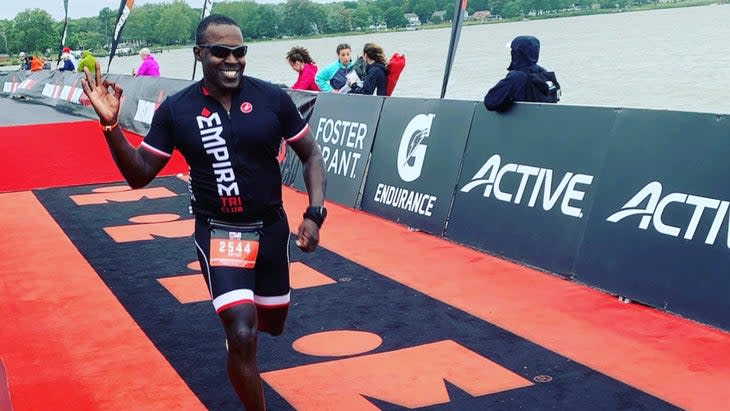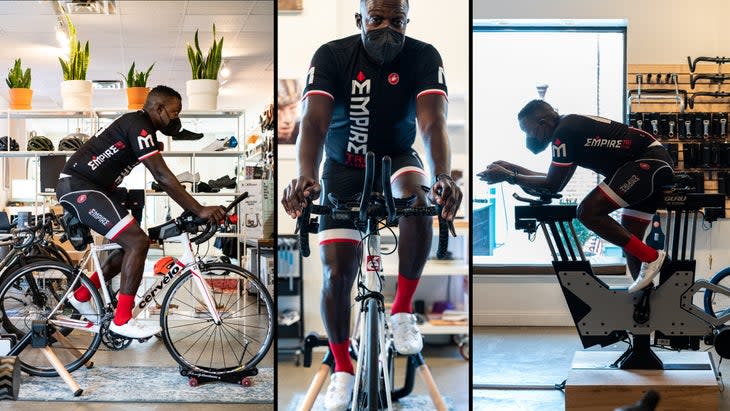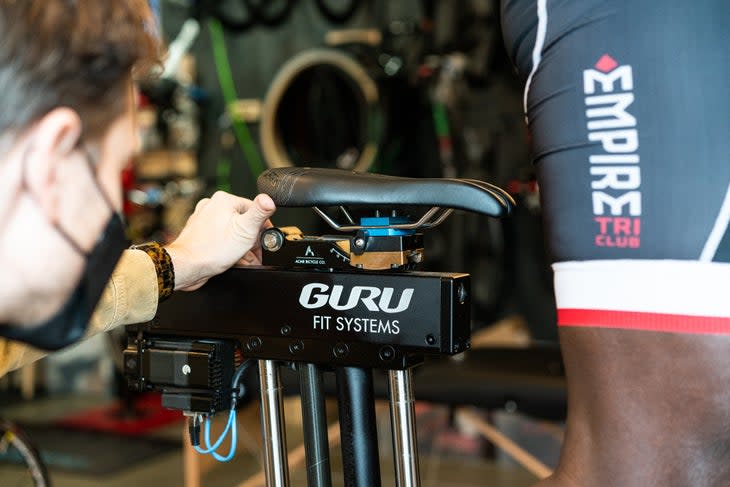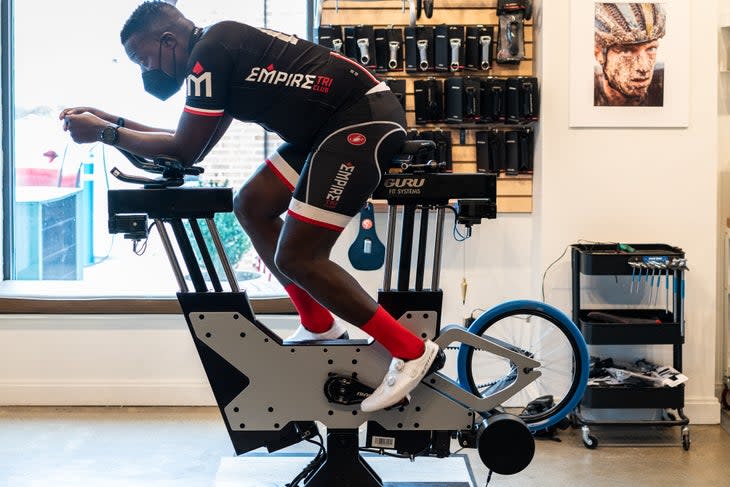Critique My Fit: Hand Numbness, Shoulder Pain, and a High Seat
In Critique My Fit, we choose one of our members to get a free virtual fit from an expert bike fitter. This month, it’s actually in-person (!) and our fitter is Colin Tanner, owner of Brooklyn-based ACME Bicycles, a Retul and Guru Certified Bike Fitter, and former USA Cycling Certified coach.
For this piece, we’ve actually brought in our “Regular Joe To Let’s Go” subject to ACME Bicycles’ studio for an in-person fit session. For more on this project, where we’re taking a regular triathlete and decking them out with the fanciest gear to see what a difference it makes, check out our introduction to our “regular joe,” Bryant. The results of this session will determine the fit and specs of Bryant’s new bike: a Quintana Roo V-PR.
Bryant’s information and fitter responses have been lightly edited for clarity and length.
For your chance to get a free virtual fit from one of the top fitters in the country, be sure to sign up for Outside+.
“I live in Rockland County, NY--about 25 miles northwest of Manhattan. After a few years of road running and Marathons, I finally decided to pursue triathlon in 2016, with the ultimate goal of completing a 140.6 Ironman. After a few sprint and Olympic races, I successfully completed the 70.3 and 140.6 Ironman distances in 2019. During my training, I experienced a range of issues that prompted me to modify my gear and fitting. I purchased my road bike--a 56cm 2015 Cervelo RS--in early 2016. It was barely used at the time. I received a basic fitting included with the purchase.

Some vitals:
– Height: 5'11
– Inseam: 32"
– Age: 52
– Gender: Male
It was mostly fine until I moved up to the 70.3 distance in June 2019. My first signs of trouble were with hand numbness, saddle soreness, and shoulder/neck fatigue. The shop made some adjustments, but I would say I survived the 70.3 with more discomfort than pain.
I continued training for a 140.6 in September 2019, but the issues were further exacerbated as I increased distance. In addition to the previous issues, I began to experience an intense hot foot after/around 60 miles and a sore left knee. I was advised to get a more robust fitting at that point. Over sessions that spanned about month, we tweaked the setup, but also made a number of gear changes a month or two prior to the race as follows:
– Cycling Helmet: Rudy Boost 01 with Visor
– Saddle: Specialized Phenom
– Aerobars: Zipp Vuka Alumnia Evo 110
– Cycling Shoes: Specialized S-Phyre
The decision to add the aerobars appeared to add efficiency and power. However, I needed to switch to visor setup for visibility and comfort in the aero position, which I could only hold for about 45 minutes at a time. Though that seemed short, the tradeoff with shoulder and hand numbness was worth it. The hot foot and knee pain improved, but never fully resolved despite numerous tweaks, including pedal spacing and seat and handlebar positioning. During my 140.6, I had to make several stops after mile 50 to relieve the pain. I spent nearly 20 minutes in transition until my body was comfortable enough to run.
Overall, biking has not been an enjoyable experience. Frankly, the pain I experienced was very discouraging, but I am not giving up. It's frustrating because I felt it had less to do with my fitness. For all of the training and hard work I put in, knowing that this pain is coming--probably preventable--was a mental block for any future racing. Despite this, I scheduled several races for 2020 (all canceled), because I believe many of these issues could be addressed/improved with a proper fitting. I started off 2021 with a race plan, but decided to focus on key marathon goals that were deferred.
I am scheduled for a few sprint and olympics leading up to a 70.3 in May. Having completed my main marathon goals in 2021, I think this is the distance I would like to focus on going forward. I do want to complete a 140.6 again eventually because I feel I can definitely improve on my bike performance.
One specific thing I would like to highlight is my seat height--it seems quite high. Perhaps to compensate for the other issues? Nonetheless, it does play a factor--mounting and dismounting have become hazardous for me--when riding in dense traffic areas between/in my home and New York City area where I work.”
-Bryant F.

Bryant is taking the leap from a road bike to a full-on modern tri bike. While there are plenty of performance benefits that can be achieved with this change, there are some specific considerations that come along with ensuring a smooth transition.
So far, Bryant has struggled with the impact of the bike leg on the rest of his race. There is certainly some work to be done as we get Bryant ready for the 2022 season. For this session, the goal is to determine, adjust and position the triathlon contact points in space that will best set Bryant up for a successful season on his new Quintana Roo V-PR.
Road To Tri Position
In some ways, the triathlon position is an evolution of the road position. The rider is essentially pivoted forward or rotated around the bottom bracket. As a result, the hip angle is opened up, the back angle is dropped, and the arms are bent with arm pads rather than handlebars supporting the increased frontal weight. The resulting triathlon frame geometry as well as the specificity of the contact points are to enable and complement the position. Like Darwin's finches evolving their beaks to the foods they ate, saddles and aerobars have evolved to meet the positional demands of a tri bike.

The Fit
Our first order of business was the saddle choice. The saddle is the cornerstone of healthy posture and good fit on any bike. After a trial of some of today's top saddles, with quick changes from our own "Seat Cleat," we settled on the ISM PN 3.1. This saddle is a softer version of the highly successful PN 3.0 (and slightly narrower than the PN 4.1). I find that people new to the triathlon position find the added cushioning more palatable. The direct ischial ramus pressure that results from a triathlon position and saddle can take some time to get used to.

Moving forward to the aerobars, we adjusted both the width and tilt until we found stability and comfort. For Bryant, we kept the arm pads a bit wider. This is helpful for those with shoulder and back flexibility issues, but also will make handling the tri bike easier as you first learn to get comfortable on your new speed rig. With the added weight on the handlebars compared to a road bike, a tri bike’s steering takes some getting used to. After some cleat adjustments and observations of Bryant's pedaling and flexibility, we landed on 170mm cranks.

Xs and Ys
With some careful attention to contact points, we can now move on to determining where in space exactly everything belongs. We use the Guru DFU 2.0 to find those "x" and "y" coordinates. We call the center of the bottom bracket the origin (0,0) and then we can measure the vertical and horizontal position of anything on the bike relative to that origin. At the end of the day, we will end up with a saddle position and handlebar position--this is what will determine the size and configuration of the Quintan Roo VP-R required to achieve our final position.
To everyone's benefit, Bryant was naturally very posturally aware. He has a nice long back posture and good hip rotation. As a fitter, this makes my job easier. Most riders, especially those in an unfamiliar position can shy away from a potentially performance enhancing long position. With the Kickr trainer holding the resistance constant, we can focus on comfort and efficiency while we work through saddle height, handlebar reach and stack, and finally rotating the position as far forward as we can while Bryant's comfort and racing goals keep us in check.

As a rider rotates further forward, we are looking to strike a balance between weight balance and pedaling efficiency. Most riders will experience a smoothening of the pedal stroke as they rotate forward. This is due mostly to the hip angle opening, thereby reducing the angle at the weakest moment in the pedal stroke. As we rotate forward, however, we are increasing weight in the arm pads which at some point becomes too much to bear. With our position set, we can now look into sizing the VP-R.
Matchmaker
Back before the days of the modern integrated, proprietary triathlon/spaceships, we could calculate which stem and spacer configuration would be required based on a frame's stack and reach numbers. The main concern is to locate the arm pads in the correct location (again using the bottom bracket as our origin) to ensure that the bike we prescribe can measure up to our fit numbers. This is very much the case today, but the process of prescribing is less universal and manufacturers have conveniently created specific charts to make this process less of an exercise in trigonometry. At our shop, we have always created tools to make this prescription process as pain free as possible. Our newest tool is the "Acme Match Maker." Essentially, we feed it the specific front-end adjustment boundaries of each bike in each size, and the result is a chart with the perimeter of arm pad locations plotted. We can then enter a rider's specific armpad coordinates based on our fitting and quickly see if and how a specific bike model will fit the rider.
In Bryant's case, we are really only concerned with one model, but because we have translated each bike into the same language, we can also quickly see how any tri bike would fit him. For the Quintana VP-R we are looking at a situation where multiple frame sizes would technically fit Bryant. This is the case with most bikes. There is overlap in the ranges of adjustment. You can see in the chart below, the red dot is clearly inside the red and blue rectangles, and just barely on the edge of the teal rectangle. I want to ensure that Bryant is fitting the bike today, but that he will also be able to make adjustments in the future, if needed.

As a new position, I would expect some changes to come about as Bryant spends more time on the bike. We went with a size 56 VP-R--which will result in a bike that has ample room for adjustment from our target point today, without being oversized. The size 58.5 would also get us to our target, but the bigger frame would also present some standover issues, which he had already mentioned in his previous assessment.
What's Next?
Once we have the bike back at the shop, we will take the detailed fit data and replicate the fit on Bryant's shiny new VP-R. A quick session on the stationary trainer will help us make any necessary micro-adjustments. Commonly, we will play with the extensions until we are comfortable with the location of the bar-end shifters and his arm/hand ergonomics. I also hope to see Bryant after he has had some time getting used to the new position and bike, as this extra feedback often leads to small, but valuable tweaks. I am looking forward to seeing how Bryant's journey shapes up!
This piece is a part of our “Regular Joe To Let’s Go” ongoing series, where we take a mid-pack triathlete and help him with every aspect of his gear--from fit to expert shopping consults to free high-end tri equipment. Read more here.

